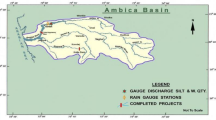Abstract
Flood is one of life-threatening events in different parts of Ethiopia. The causes of flood might vary from place to place, for instance, rates of deforestation, agricultural expansion, urbanization, wetland drainage, climate change, siltation of river bed, and several other types of land use change might be the cause for flood in different rivers banks. This study aims to assess, investigate, and design suitable river training works on lower Kulfo river reach. The study reach has been seriously affected by extreme floods due to the above reasons. For minimizing the loss due to flood, and to use the advantage of flood for different developmental activities various flood control measures should be adopted. The flood control measures which should more correctly be termed as “flood management” can be planed either through structural engineering measures or non-structural measures. Structural measures comprise retarding structures which store flood water, channel improvements which increase flood-carrying capacity of the river, embankments, and levees which keep the waterway from flood-prone area, detention basin which retards and absorbs most of the floodwater. Within the identified 6 km reach, field investigation including secondary data collection has been done to predict the flood extent using 1D hydrodynamic model, HECRAS and HEC Geo RAS. Estimated flood depth and extent helped us in fixing the dimension of different river training structures selected. The modelling result indicates a maximum channel bed flood depth of 4.3 m and flood plain flood depth 2.3 m obtained using a 100-year return flow. Analysis of soil samples indicates that the lower reach of Kulfo river is gravel and sand dominated meandering river, with estimated scour depth up to 3.41 m along the river course. Levees have been designed in conjunction with Groynes to protect the Upstream farm located at the prison and upper part of the Limat households. Frequent floods happening near both bridges shall be reduced by using Guide banks without influencing the bridges and diversion structures. Consideration is given for the ecosystem to stay in equilibrium, by providing suitable outer slopes so that plantation is possible on the top and side slope of the levees and guide banks.















Similar content being viewed by others
References
Bakker MA (2019) Morphological response of an alpine braided reach to sediment- laden flow events. J Geophys Res: Earth Surf 1310-1328
Balan K (2016) River bank erosion control using coir geotextiles. IWRA (India) Journal (Half Yearly Technical Journal of Indian Geographical Committee of IWRA) 31–36
Barnes HH (1967) Roughness characteristics of natural channels (No 1849). US Government Printing Office. University of California
Brunner GW (2010) HEC-RAS river analysis system: hydraulic reference manual. US Army Corps of Engineers, Institute for Water Resources, Hydrologic Engineering Center
Garg SK (2005) Irrigation Engineering and hydraulic structures. New Delhi
GC E, Adhikary RP, Shrestha AB, Rai SK (2012) Physical Methods for River Training. ICIMOD
Hashemi NSFA, Ayoubzadeh SALI, Dehghani AA (2008) Experimental investigation of scour depth around L-head groynes under clear water condition. J Agric Sci Nat Resour 15(1):192–203
Higaki D, Karki KK, Gautam CS (2005) Soil erosion control measures on degraded sloping lands: A case study in Midlands of Nepal. Aquat Ecosyst Health Manag 8:243–249
Julien PY, Klaassen GJ, Ten Brinke WBM, Wilbers AWE (2002) Case study: bed resistance of Rhine River during 1998 flood. J Hydraul Eng 128:1042–1050
Lewelling BR (2004) Extent of areal inundation of riverine wetlands along five river systems in the upper Hillsborough River watershed. West-central Florida (N0 2004). US Geological Survey. Citeseer
McCullah J, Gray DH (2005) Environmentally sensitive channel-and bank-protection measures. Transportation Research Board, Washigton DC
Parrett C, Johnson DR (2004) Methods for estimating flood frequency in Montana based on data through water year 1998. US Department of the Interior. US Geological Survey. Reston, VA. Denver
Safarzadeh A, Salehi Neyshabouri SAA, Ghodsian M, Zarrati AR (2010) Experimental study of head shape effects on shear stress distribution around a single groyne in river flow. In: Proceedings of 5th International Conference on Fluvial Hydraulics, pp 651–657
Singh G (1980) Irrigation engineering. Standard Book House, Delhi
Staff U (2008) HEC-RAS river analysis system, user’s manual version 4.0. US Army Corps Eng. Hydrol Eng Cent Publ
Te Chow V (1959) Open-channel hydraulics. McGraw-Hill, New York
Tvedt T (2010) Rivers and society. From early civilizations to modern times. IB Tauris, London
USACE U (2008) Compensatory mitigation for losses of aquatic resources. Federal Register 73:19594–19705
Varshney CK (1983) Water pollution and management. Wiley Eastern Limited, New York
Yankoupe RF (1991) American River Watershed Investigation, Feasibility Report. Part 1. Main Report. Part 2. Environmental impact statement/environmental impact report. Army Engineer District Sacramento CA. California
Author information
Authors and Affiliations
Corresponding author
Additional information
Publisher's Note
Springer Nature remains neutral with regard to jurisdictional claims in published maps and institutional affiliations.
Rights and permissions
About this article
Cite this article
Abdella, K., Mekuanent, F. Application of hydrodynamic models for designing structural measures for river flood mitigation: the case of Kulfo River in southern Ethiopia. Model. Earth Syst. Environ. 7, 2779–2791 (2021). https://doi.org/10.1007/s40808-020-01057-5
Received:
Accepted:
Published:
Issue Date:
DOI: https://doi.org/10.1007/s40808-020-01057-5




